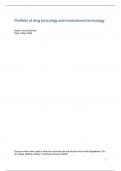Samenvatting
Summary of the course material of drugs toxicology and drug translational technology
- Instelling
- Rijksuniversiteit Groningen (RuG)
Summary of all lectures, when learning this summary you can get a good grade for the course. With this summary you can see what to include in your portfolio, which you have to submit to pass the course. I also included the powerpoint which I made with my group.
[Meer zien]




